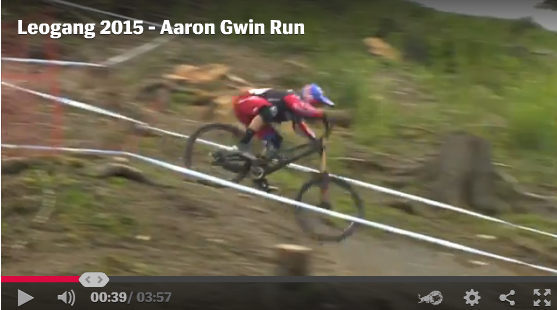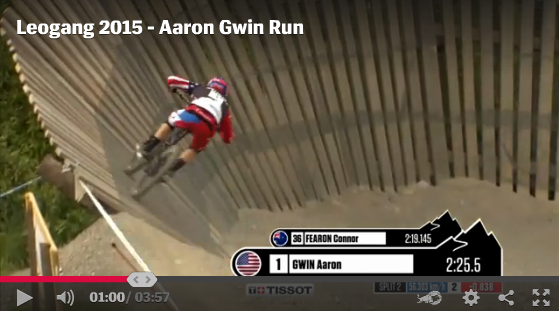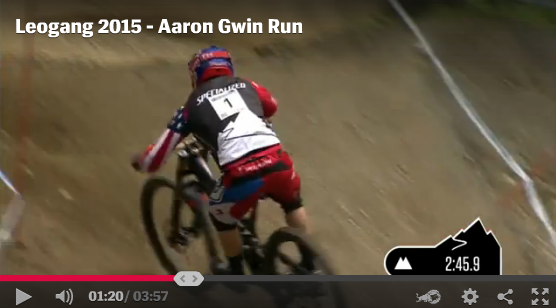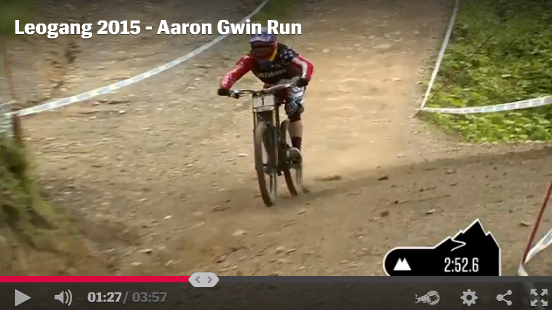Aaron Gwin wins — chainless!

By now most of the internet knows Aaron Gwin won last week’s World Cup downhill in Leogang without a chain. He broke it out of the gate, shrugged it off then railed and pumped his way to a win — over the best riders in the world — the rest of whom pedaled!
Totally rad. Go Aaron. Go America. Go God.
Update July 3, 2015: Added link and summary of Dirt article “Aaron Gwin – Chainless – How did he do it?”
Announcer: “Are we going to see a Neko Mulally style run?”
No. Neko’s chainless 4th at DH Worlds was impressive. This is a #1. The big W.
Something happens, even at this level, when you know you can’t pedal. You look farther ahead, work more of the shapes, lay off the brakes and carry more speed.
But: You can see Aaron braking hard for some turns. He enters at a speed he can handle, then he drives through the exit. Way better than rushing in, blowing the turn then sprinting out. A lesson for everyone — even us mortals with chains.
I’ve always been a fan of Aaron’s riding style: a perfect melding of moto amplitude with bike mechanics. He’s low, he makes big angles. His body (the sacred cargo) just floats while his Demo, hands and feet make beautiful violence.
Mechanically, the difference between a good rider and a great rider can be very subtle (basically invisible and “magic” to the civilian eye). This run is full of gems:
0:38 – He pushes his bike across the bump, rather than waiting for the backside and pushing down. Sine Wave of Love, baby. Look at how low he is!
1:00 – Aaron pre-hops then smashes the very beginning of the big, wooden berm. By applying pressure to the beginning of the turn rather than the end, he’s driving his bike down the track, rather than bleeding speed into the bank.
1:15 – He slows way down! A normal person might be tempted to rush things, but Aaron’s being patient. He knows how fast he can handle this nasty turn, and he knows he’ll regain speed on the steep exit.
1:20 – A subtle and perfect application of lateral pump. See Pumping flat ground in the real world. This skill can be mastered in your neighborhood.
1:28 – More hard braking, then a heavy turn initiation, a light exit then a crush of a backside. Bam. Back up to speed.
And so on down the course. If you look carefully, you’ll see that Aaron’s executing the same core movements over and over again — with perfect timing and great power.
In LLB in-person and remote skills classes, we teach these “meta skills” to ordinary riders (and pros too). You can master them in your neighborhood and local trails. Once they’re integrated, you can shred pretty much anywhere. With or without a chain.
Update July 3, 2015
Check out this Dirt article and video: Aaron Gwin – Chainless – How did he do it?
Main points:
They say the Demo rides better without a chain. A bit surprising to me considering how little FSR suspension affects chain growth.
Riders who can pedal might waste energy trying to pedal in places that aren’t so helpful.
Without a chain, you have to be more focused on line choice, braking and pump.
Without pedaling, you have more energy for everything else.
But, as they said, a World Cup racer would be crazy to line up without a chain. No margin for error.
Know more. Have more fun!
Join the leelikesbikes mailing list:




Leave a Reply
Want to join the discussion?Feel free to contribute!